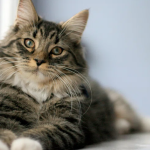Living with a cat brings immense joy, yet hairballs aren’t part of the appeal. While common, these furry masses aren’t an unavoidable aspect of feline life. Here’s a closer look at why hairballs occur, how to recognize and address them, and tips for prevention.
Understanding Cat Hairballs: Typically, hair should pass through a cat’s system without issue. Hairballs occur when fur accumulates in the digestive tract, forming clumps that are expelled via vomiting. These can vary in appearance from tubular wads to loose tangles mixed with fluid or food.
Reasons for Hairball Formation: Cats groom regularly, ingesting fur in the process. Excessive hairball occurrences might be due to increased shedding, stress-induced overgrooming, or underlying health conditions affecting the gastrointestinal tract.
Identifying Hairball Episodes: Contrary to popular belief, the process isn’t about “coughing up” but rather retching and vomiting. Cats may exhibit restlessness, vocalization, and abdominal contractions during these episodes. Promptly seek veterinary advice if vomiting persists or if your cat seems distressed.
Addressing Hairballs: For infrequent episodes, certain home remedies can aid in passage:
- Over-the-Counter Solutions: Hairball-control gels like Laxatone ease fur transit.
- Natural Remedies: High-fiber supplements and herbal treatments support digestive health.
- Hairball Treats and Foods: Specially formulated treats or high-fiber foods can aid in managing hairballs.
Avoid using cooking oils, fats, or mineral oil, as they are ineffective or potentially harmful.
Veterinary Diagnosis and Treatment: Frequent hairballs may indicate underlying health concerns. A vet will conduct a thorough examination and might recommend skin scrapings, blood work, X-rays, or biopsies to identify the cause. Treatment varies based on the diagnosis and might involve dietary changes or medical intervention.
Preventing Hairballs:
- Regular Brushing: Especially vital for long-haired cats to reduce ingested hair.
- Hairball-Control Aids: Use hairball-control gels or switch to specialized foods rich in fiber.
- Collaborate with Your Vet: Discuss strategies for managing and preventing hairballs tailored to your cat’s needs.
By working together with your vet and implementing preventive measures, you can ensure your cat’s comfort and minimize the hassle of hairballs in your shared living space. Your cat will thank you for the care and attention!




